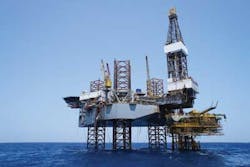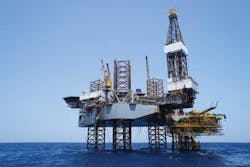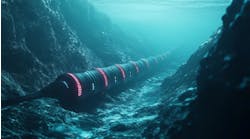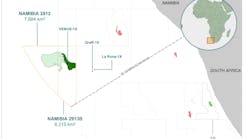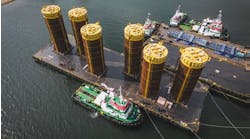Kenny Dooley
PetroPlan
There can be no doubt that the UK North Sea will remain an important region for oil and gas E&P for years to come. Most of its fields are expected to remain economically viable until 2020 if not longer, and high oil prices have given a boost to exploration in the northeast Atlantic basin in areas previously considered marginal and thereby uneconomic. The region still boasts estimated oil and gas reserves of 9.4 Bboe with a 50%-plus chance of recoverability.
Despite this, UK offshore drilling activity is in decline, and nowhere near the levels necessary to unlock the area's remaining potential. Production drilling has remained constant at about 120-130 wells per year since 2009, but remains far below pre-2009 levels. More worryingly, the last three years have seen the lowest rate of exploration activity in the region's history. In 2013 there were 44 exploration and appraisal wells drilled, below initial forecasts, and down from 53 in 2012. This year may see a lower level of activity still, with plans to drill just 25 exploration wells and 11 appraisal wells. Around 66 further exploration and appraisal wells are expected to be drilled through 2015 and 2016, suggesting that the yearly rate is not expected to rise significantly.
This is not just a concern for the industry, but for the UK as a whole. Offshore oil and gas continues to be the UK's largest industrial investor, paying more tax to the Exchequer than any other corporate sector. North Sea oil and gas supports around 450,000 jobs across the country and contributes to around 1.5% of national GDP. Without domestic production, Britain would have had to import an extra £31 billion ($53 billion) worth of energy in 2012.
So what are the factors behind this dip in activity, and what obstacles do drilling companies in the North Sea face? Much comes down to the sector's inherent volatility. Drilling companies largely operate on a project-by-project basis, the availability and location of which are highly sensitive to volatile factors such as the prices of oil and gas, the emergence of new technology, and new discoveries. Opportunities can arise with little notice, leaving companies scrambling to take advantage. On the other hand, a dip in prices can lead to prolonged periods of reduced activity.
For drilling companies this volatility manifests itself in three main ways: access to rigs, access to financial capital, and access to human capital.
No money, no rigs
Demand for rigs, and their lack of availability during periods of high activity, is a major challenge facing North Sea exploration drilling. Of the 55-60 exploration and appraisal wells forecast to be drilled last year, 20 were postponed and four cancelled. Of the postponements/cancellations, 42% were due to a lack of rig availability. Another 8% involved cases where the company had secured a firm rig slot to drill, but delays on other drilling sites prevented take-up.
The number of mobile rigs deployed offshore the UK at the end of 2013 was the highest since 2008 (20 jackups and 19 semisubmersible rigs); however, relative to the region's potential this still represents a shortfall. Current high rig rates (combined with the fact that the average drilling period has risen to 17 days) only increase the strain.
A lack of access to funding acted as a further brake on exploration in 2013, accounting for a further quarter of the postponements and cancellations. As might be expected, the situation hit smaller drilling companies disproportionately hard relative to their larger, more resilient counterparts. As a result, small- to medium-sized companies contributed just 25% of wells in 2013, a lower share than in previous years (partly offset by increased activity on the part of energy utilities during the same period).
The people problem
Another major concern is the difficulty getting staff with the required technical skills to the right place and for the right duration, often at short notice. This challenge is common to drilling companies across the world. The global oil and gas industry faces an acute shortage of workers with 10-15 years' experience, thanks to a near universal shutdown of training and recruitment programs during the 1980s oil gut, when prices hit record lows.
However, there are additional issues that exacerbate the challenge in the North Sea region. First is competition with other world regions – in an industry already short on human capital – that makes it especially difficult to retain talent. Drilling personnel working abroad might typically command salaries 35-50% higher than those of their UK North Sea-based counterparts, and the difference becomes marked when taxes and bonuses are considered.
Aside from the pay, it is also a matter of job satisfaction and the opportunity to work with cutting-edge technology. The North Sea is a mature region, filled with aging and largely manually operated drilling rigs incorporating older technology. Other regions tend to have a higher proportion of newer generation rigs featuring much higher levels of drill floor automation and comfort for crews. Many newer generation mobile rigs offer far better conditions for workers and a host of extra facilities designed to improve their living standards.
Logistical acrobatics
Rig availability is largely a matter of supply and demand beyond the immediate control of drilling companies, as are the factors that dictate the availability of financial capital. Therefore, drilling companies have limited options to mitigating the impact of volatility.
More can be done in terms of human capital. Some companies are engaging in "logistical acrobatics" to minimize the people problem, incentivizing workers to remain offshore instead of departing for leave, or to work extra shifts. The "quasi-demotion/promotion" is another weapon in the arsenal, e.g. an assistant driller might be promoted to a driller on a per-project basis, and a tool-pusher might be "demoted" to driller to fill an urgent gap, while remaining on the higher tool-pusher rate of pay.
Some companies in the UK North Sea are reorganizing shift rotations to make hours more appealing to prospective workers. "Roving trips" are increasingly common, giving candidates a chance to travel and work on different rigs. Another measure (at least within larger organizations that have the capacity) is to identify when your international workers will be home, and use them at this point. For instance, a contractor working on a 28 days on/28 days off rotation in Angola may be amenable to a two-week shift in the North Sea while back home.
However, the real key to mitigating the impact of volatility on human capital is to widen the talent pool for recruitment, both geographically and by tapping other sectors. For historical and cultural reasons, many oil and gas companies remain reluctant to hire outside of the local market, at least in mature fields within developed Western economies (such as in the North Sea or Canada). Yet a planning engineer (for instance) is more or less the same whether from London or from Calgary.
A senior project engineer from Dubai who had secured permanent residency status in Canada was looking for work at a major Canadian oil and gas company. Having previously applied for various vacancies via the company's online portal without receiving a single response, he would come into the company's office nearly every day of his final visit to Canada, frantically seeking work prior to the daunting step of relocating his family. Yet he was routinely dismissed.
The company in question had installed a third-party recruitment specialist firm that same week. Once they reviewed the applicant's CV and talked to him, it became clear that his previous experience in Dubai would make him a very good fit for a role in the Canadian company, which he secured within three days. The worker proved a good hire, was rapidly promoted to project manager, and the company is now far less reticent about hiring from outside of the local market.
This is starting to happen among North Sea companies, which are increasingly recruiting those with experience on land rigs, particularly from North America and Eastern Europe. These workers require minimal training to get up to speed on offshore rigs, and there is often a greater economic incentive for them, especially for workers from Eastern Europe. For instance a land-based driller from Croatia may be able to double take-home pay when working in the UK North Sea. Roles in international waters, while attractive, are highly competitive – for these candidates the North Sea affords an opportunity to get into the offshore business and build valuable experience. And more and more, companies are offering staff retention bonuses that rise with every continued year of service, as a means of encouraging skilled workers to stay put.
The other major way to maximize the talent pool is for the industry to overcome a similar historical and cultural reluctance to hire sideways from other sectors that cultivate transferable skills. In certain countries such as Australia and South Africa this can mean taking advantage of similar roles in said countries' large mining sectors, and companies operating in the UK North Sea have access to a pool of ex-servicemen and women.
While companies can do more to mitigate the impact of the people problem than they can a lack of rigs or poor economy, there is still no magic solution. Companies need to be flexible and use all resources at their disposal to retain and attract talent. A common factor behind successful sideways and global hiring is the use of third-party workforce specialists such as recruitment agencies. It was a recruitment agency which – thanks to its understanding of the industry together with its experience in the Middle East – helped the Canadian company see the potential in the project engineer from Dubai. In a situation where demand is so high, and timing so crucial, positions can be routinely filled in mere minutes after becoming available simply by being able to tap into a global network of highly skilled workers. To have access to the full picture of just who is available, and when, can put firms at a major advantage.
Sources
Page 5, Oil and Gas UK Activity Survey 2014.
Page 13, Drilling Activity + Page 20, Exploration Outlook, Oil and Gas UK Activity Survey 2014
https://www.gov.uk/government/news/north-sea-still-attractive-for-oil-and-gas-industry
Page 14 onwards, Exploration and Appraisal Drilling, UK Oil and Gas Activity Survey 2014.
Page 16, UK Oil and Gas Activity Survey 2014.
